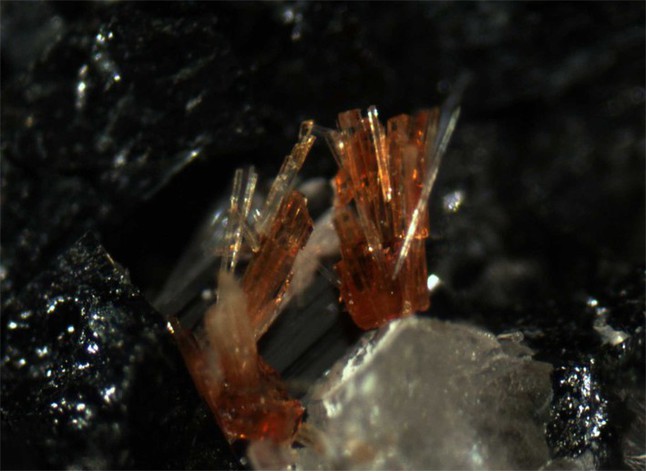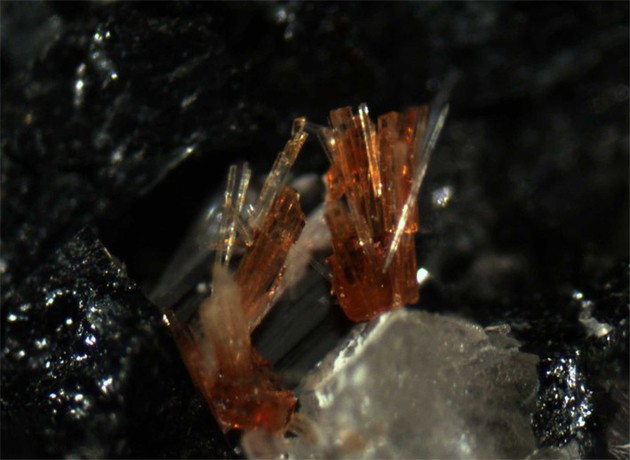Kukisvumite
A valid IMA mineral species
This page is currently not sponsored. Click here to sponsor this page.
About Kukisvumite

Kirovskii Apatite mine. Summer 2013
Kirovskii apatite mine, Kukisvumchorr Mt, Khibiny Massif, Murmansk Oblast, Russia
Kirovskii apatite mine, Kukisvumchorr Mt, Khibiny Massif, Murmansk Oblast, Russia
Formula:
Na6ZnTi4(Si8O24)O4 · 4H2O
Colour:
White to colorless, some grains with a silver tint
Lustre:
Vitreous
Hardness:
5½ - 6
Specific Gravity:
2.90
Crystal System:
Orthorhombic
Name:
Named for Mount Kukisvumchorr, Russia, the type locality.
The Zn analogue of manganokukisvumite and (the Zn0.5-analogue of) lintisite. AM-4 family of natural titanosilicates.
Compare the other two group members: eliseevite and punkaruaivite.
Compare the other two group members: eliseevite and punkaruaivite.
Unique Identifiers
Mindat ID:
2283
Long-form identifier:
mindat:1:1:2283:1
GUID
(UUID V4):
(UUID V4):
d45f76b3-b4e5-4ccb-83a6-40c93da0f9f5
IMA Classification of Kukisvumite
Approved
IMA Formula:
Na6ZnTi4O4(SiO3)8 · 4H2O
Approval year:
1989
First published:
1991
Classification of Kukisvumite
9.DB.20
9 : SILICATES (Germanates)
D : Inosilicates
B : Inosilicates with 2-periodic single chains, Si2O6; Pyroxene-related minerals
9 : SILICATES (Germanates)
D : Inosilicates
B : Inosilicates with 2-periodic single chains, Si2O6; Pyroxene-related minerals
65.1.6.2
65 : INOSILICATES Single-Width,Unbranched Chains,(W=1)
1 : Single-Width Unbranched Chains, W=1 with chains P=2
65 : INOSILICATES Single-Width,Unbranched Chains,(W=1)
1 : Single-Width Unbranched Chains, W=1 with chains P=2
Mineral Symbols
As of 2021 there are now IMA–CNMNC approved mineral symbols (abbreviations) for each mineral species, useful for tables and diagrams.
| Symbol | Source | Reference |
|---|---|---|
| Kki | IMA–CNMNC | Warr, L.N. (2021). IMA–CNMNC approved mineral symbols. Mineralogical Magazine, 85(3), 291-320. doi:10.1180/mgm.2021.43 |
Physical Properties of Kukisvumite
Vitreous
Transparency:
Transparent
Colour:
White to colorless, some grains with a silver tint
Streak:
White
Hardness:
5½ - 6 on Mohs scale
Hardness:
VHN20=517 - 571 kg/mm2 - Vickers
Tenacity:
Elastic
Cleavage:
None Observed
Parting:
{010}
Fracture:
Irregular/Uneven, Splintery
Comment:
Crushes into thin fibers along the elongation
Density:
2.90 g/cm3 (Measured) 2.95 g/cm3 (Calculated)
Optical Data of Kukisvumite
Type:
Biaxial (-)
RI values:
nα = 1.676(3) nβ = 1.746(3) nγ = 1.795(3)
2V:
Measured: 77° , Calculated: 76°
Max Birefringence:
δ = 0.119

Image shows birefringence interference colour range (at 30µm thickness)
and does not take into account mineral colouration.
and does not take into account mineral colouration.
Surface Relief:
High
Dispersion:
weak
Pleochroism:
Non-pleochroic
Chemistry of Kukisvumite
Mindat Formula:
Na6ZnTi4(Si8O24)O4 · 4H2O
Common Impurities:
Nb,Fe,F
Crystallography of Kukisvumite
Crystal System:
Orthorhombic
Class (H-M):
mmm (2/m 2/m 2/m) - Dipyramidal
Space Group:
Pccn
Setting:
Pccn
Cell Parameters:
a = 28.889(4) Å, b = 8.604(4) Å, c = 5.215(3) Å
Ratio:
a:b:c = 3.358 : 1 : 0.606
Unit Cell V:
1,296.25 ų (Calculated from Unit Cell)
Z:
2
Morphology:
Elongate [001], flattened [100], up to 7 mm long and 0.1 mm thick (type material)
Crystal Structure
Load
Unit Cell | Unit Cell Packed
2x2x2 | 3x3x3 | 4x4x4
Unit Cell | Unit Cell Packed
2x2x2 | 3x3x3 | 4x4x4
Show
Big Balls | Small Balls | Just Balls | Spacefill
Polyhedra Off | Si Polyhedra | All Polyhedra
Remove metal-metal sticks
Big Balls | Small Balls | Just Balls | Spacefill
Polyhedra Off | Si Polyhedra | All Polyhedra
Remove metal-metal sticks
Display Options
Black Background | White Background
Perspective On | Perspective Off
2D | Stereo | Red-Blue | Red-Cyan
Black Background | White Background
Perspective On | Perspective Off
2D | Stereo | Red-Blue | Red-Cyan
View
CIF File Best | x | y | z | a | b | c
CIF File Best | x | y | z | a | b | c
Rotation
Stop | Start
Stop | Start
Labels
Console Off | On | Grey | Yellow
Console Off | On | Grey | Yellow
Data courtesy of the American Mineralogist Crystal Structure Database. Click on an AMCSD ID to view structure
| ID | Species | Reference | Link | Year | Locality | Pressure (GPa) | Temp (K) |
|---|---|---|---|---|---|---|---|
| 0011086 | Kukisvumite | Merlino S, Pasero M, Ferro O (2000) The crystal structure of kukisvumite, Na6ZnTi4(Si2O6)4O4*4H2O Zeitschrift fur Kristallographie 215 352-356 |  | 2000 | Kukisvumtschorr deposit, Khibiny alkaline massif, Kola peninsula, Russia | 0 | 293 |
CIF Raw Data - click here to close
X-Ray Powder Diffraction
Powder Diffraction Data:
| d-spacing | Intensity |
|---|---|
| 14.49 Å | (90) |
| 6.42 Å | (60) |
| 4.815 Å | (80) |
| 3.722 Å | (65) |
| 3.009 Å | (100) |
Geological Environment
Paragenetic Mode(s):
| Paragenetic Mode | Earliest Age (Ga) |
|---|---|
| Stage 4b: Highly evolved igneous rocks | >3.0 |
| 35 : Ultra-alkali and agpaitic igneous rocks |
Type Occurrence of Kukisvumite
General Appearance of Type Material:
Fan-shaped intergrowths of long prismatic crystals.
Place of Conservation of Type Material:
Fersman Mineralogical Museum, Moscow, Russia.
Mining Museum, St. Petersburg, Russia.
Mining Museum, St. Petersburg, Russia.
Geological Setting of Type Material:
Arfvedsonite-microcline pegmatite vein that cuts ijolitic/urtitic rocks.
Associated Minerals at Type Locality:
Reference:
Yakovenchuk, V.N., Pakhomovskii, Y.A., Bogdanova, A.N. (1991) Kukisvumite - A new mineral from the alkaline pegmatites of the Khibiny massif (Kola Peninsula). Mineralogicheskii Zhurnal: 13(2): 63-67.
Synonyms of Kukisvumite
Other Language Names for Kukisvumite
German:Kukisvumit
Russian:Кукисвумит
Simplified Chinese:羟硅锌钛钠石
Spanish:Kukisvumita
Traditional Chinese:羥矽鋅鈦鈉石
Common Associates
Associated Minerals Based on Photo Data:
| 2 photos of Kukisvumite associated with Manganokukisvumite | Na6MnTi4(Si8O24)O4 · 4H2O |
| 2 photos of Kukisvumite associated with Arfvedsonite | [Na][Na2][Fe2+4Fe3+]Si8O22(OH)2 |
| 2 photos of Kukisvumite associated with Labuntsovite Supergroup | |
| 1 photo of Kukisvumite associated with Nenadkevichite | (Na,◻)8Nb4(Si4O12)2(O,OH)4 · 8H2O |
| 1 photo of Kukisvumite associated with Aegirine | NaFe3+Si2O6 |
Related Minerals - Strunz-mindat Grouping
| 9.DB.05 | Balipholite | BaLiMg2Al3(Si2O6)2(OH)4 |
| 9.DB.05 | Carpholite | Mn2+Al2(Si2O6)(OH)4 |
| 9.DB.05 | Ferrocarpholite | Fe2+Al2Si2O6(OH)4 |
| 9.DB.05 | Magnesiocarpholite | MgAl2Si2O6(OH)4 |
| 9.DB.05 | Potassiccarpholite | K(Mn2+,Li)2Al4Si4O12(OH,F)8 |
| 9.DB.05 | Vanadiocarpholite | Mn2+V3+Al(Si2O6)(OH)4 |
| 9.DB.10 | Lorenzenite | Na2Ti2(Si2O6)O3 |
| 9.DB.15 | Lintisite | LiNa3Ti2(Si2O6)2O2 · 2H2O |
| 9.DB.15 | Punkaruaivite | LiTi2(HSi4O12)(OH)2 · H2O |
| 9.DB.17 | Eliseevite | LiNa1.5Ti2(H1.5Si4O12)O2 · 2H2O |
| 9.DB.20 | Manganokukisvumite | Na6MnTi4(Si8O24)O4 · 4H2O |
| 9.DB.25 | Vinogradovite | Na4Ti4(Si2O6)2[(Si,Al)4O10]O4 · (H2O,Na,K)3 |
| 9.DB.25 | Paravinogradovite | Na1-2(Ti,Fe3+)4(Si2O6)2(AlSi3O10)(OH)4 · H2O |
| 9.DB.30 | Nchwaningite | Mn2+2(SiO3)(OH)2 · H2O |
| 9.DB.35 | Plancheite | Cu8(Si8O22)(OH)4 · H2O |
| 9.DB.40 | Shattuckite | Cu5(Si2O6)2(OH)2 |
| 9.DB.40 | UM2005-31-SiO:CuH | Cu11(SiO4)(OH)18 · 9H2O (?) |
| 9.DB.45 | Aerinite | (Ca5.1Na0.5)(Fe3+,Al,Fe2+,Mg)4(Al,Mg)6[HSi12O36(OH)12][(CO3)1.2(H2O)12] |
| 9.DB.50 | Capranicaite | KCaNaAl4B4Si2O18 |
Other Information
Notes:
Yellow-green luminescence in the electron microprobe beam
Health Risks:
No information on health risks for this material has been entered into the database. You should always treat mineral specimens with care.
Internet Links for Kukisvumite
mindat.org URL:
https://www.mindat.org/min-2283.html
Please feel free to link to this page.
Please feel free to link to this page.
Search Engines:
External Links:
Mineral Dealers:
References for Kukisvumite
Localities for Kukisvumite
Locality List
 - This locality has map coordinates listed.
- This locality has map coordinates listed.
 - This locality has estimated coordinates.
ⓘ - Click for references and further information on this occurrence.
? - Indicates mineral may be doubtful at this locality.
- This locality has estimated coordinates.
ⓘ - Click for references and further information on this occurrence.
? - Indicates mineral may be doubtful at this locality.
 - Good crystals or important locality for species.
- Good crystals or important locality for species.
 - World class for species or very significant.
(TL) - Type Locality for a valid mineral species.
(FRL) - First Recorded Locality for everything else (eg varieties).
- World class for species or very significant.
(TL) - Type Locality for a valid mineral species.
(FRL) - First Recorded Locality for everything else (eg varieties).
All localities listed without proper references should be considered as questionable.
Russia | |
| Min.Zhurnal (1991) |
| Pekov (1998) |
| Yakovenchuk et al. (2005) | |
| ... |
Quick NavTopAbout KukisvumiteUnique IdentifiersIMA Classification Classification Mineral SymbolsPhysical Properties Optical Data Chemistry Crystallography Crystal StructureX-Ray Powder DiffractionGeological EnvironmentType Occurrence SynonymsOther LanguagesCommon AssociatesStrunz-MindatOther InformationInternet Links References Localities Locality List






 symbol to view information about a locality.
The
symbol to view information about a locality.
The 



Kirovskii apatite mine, Kukisvumchorr Mt, Khibiny Massif, Murmansk Oblast, Russia